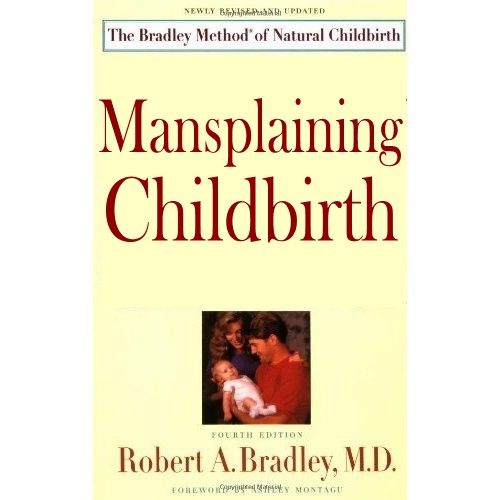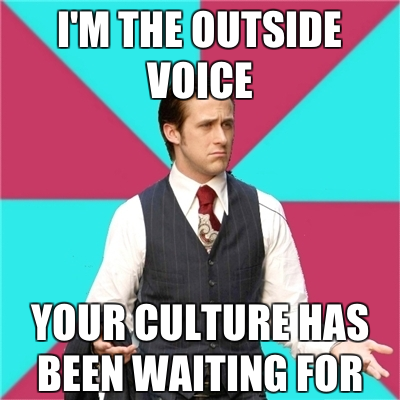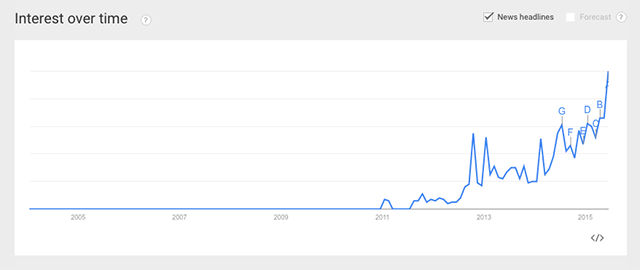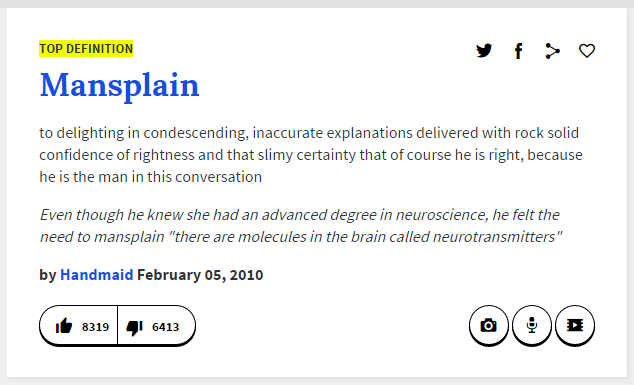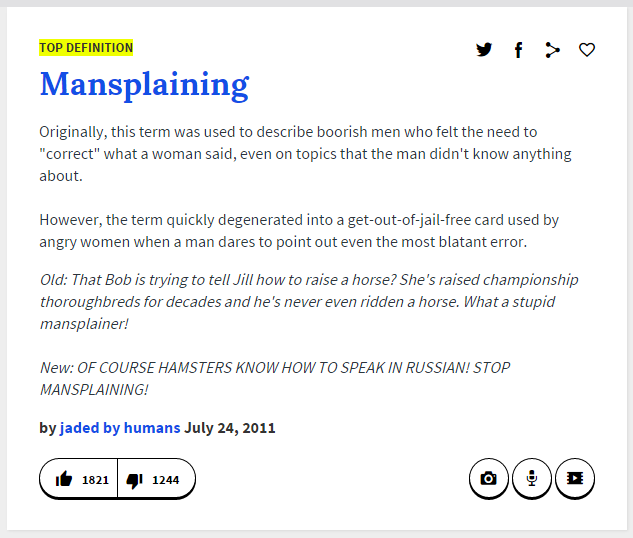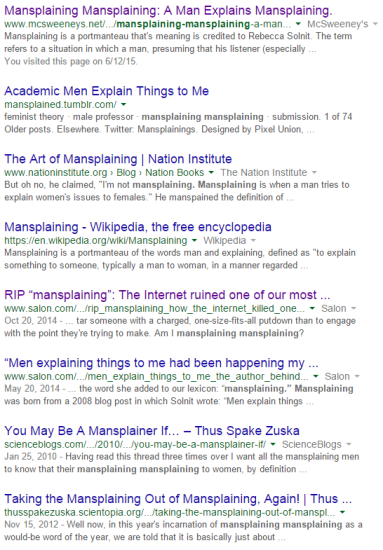Have you noticed the word "mansplaining" appearing a lot lately online? Are you not sure what it means, or why people seem to be upset about it?
A friend spotted this in Texas: #Mansplaining The Statue. pic.twitter.com/87RkAkuLcI
— Cathy de la Cruz (@SadDiego) May 22, 2015
Mansplaining is a controversial term, socially and politically charged, and has been subject to very different definitions and opinions. If you've ever wondered what it means, where it came from, and how it got to be so charged, you're in the right place.
If you're wondering what's the deal with the statue, we'll come back to it in a bit.
What is Mansplaining?
Mansplaining is a portmanteau of the words "man" and "explaining", and refers to situations where a person (typically a man) explains something to someone else (typically a woman), often in a condescending way, without consideration for or regard to the explainee being more experienced with the subject in the first place.
Examples
A man who explains to a mother what childbirth is like would be mansplaining. (Note that I specified that the woman is a mother, because, women do not have an innate and/or magical knowledge of childbirth). If that all seems simple enough, it's about to get way more complicated.
Spin-offs of Mansplaining
You could use mansplaining to refer to non-gendered situations.
For example, it could be used in scenarios where, hypothetically, a white person (either male or female) "mansplains" to a black person who works in social justice that there are more black people than white people in jail in the United States because the black people were brought up badly (obviously failing to take into account systemic racial injustices such as racial profiling, and more importantly, ignoring the wealth of experience the black social justice worker has). Mansplaining would cover the sentiment, but the situation may be a little clearer for your listeners if you use the term "whitesplaining".
It gets even more dicey here on whether someone would understand you, but you could even use mansplaining to refer to when a woman explains something to a man without regard to him knowing more about it than her. For example, a woman who explains to a man about keeping a bathroom clean, even though the man is a professional custodian, could be considered a "mansplainer" as well.
The point is that the speaker is assuming to know better, without considering the life experience and qualifications of the person they're talking to. It's extremely frustrating for the listener, who usually can't get a word in edge wise.
Some History
Mansplaining is a relatively new word. According to KnowYourMeme (an encyclopedia of Internet memes), mansplaining was coined in 2008 in the comments section of a LiveJournal community shortly after an essay entitled "Men Explain Things To Me" by Rebecca Solnit appeared in the Los Angeles Times.
The word started to spread as a term people actively searched for in 2011. You can see for yourself thanks to Google Trends' search report on the term:
The idea behind mansplaining is not a new one, though. As Lily Rothman explains in an article for The Atlantic, people have been mansplaining long before there was a word for it.
Lyman Abbott once wrote (in the same magazine, in 1903!), "Why Women Do Not Wish the Suffrage". It's a perfect example of a mansplainer: a person who thinks and writes like he knows what women want better than women do themselves.
As the term started to popularize, it became a point of online contention between feminists and people who oppose feminism. Just take a look at this top Urban Dictionary definition for mansplain (awkward grammar aside):
Compare it to another top Urban Dictionary (a site for crowdsourced slang definitions) definition for mansplaining:
The Problem
Part of the problem with the term "mansplain" is that it makes the practice of "'splaining" (to remove the gendering from the term), or speaking in a way that dismisses someone else's experience, a gendered one – but for many people, that's the point. It's a gendered term because men seem to "'splain" more than women.
Though anyone can speak condescendingly to other people, women, along with minority groups, have a long history of being silenced, or otherwise punished for speaking up. The term has value for people who advocate for minority voices to be heard. However, as Benjamin Hart explains (mansplains?), lately the term has been misused completely, referring to times when men say things to or about women. It's unfair to bar half the population from a form of communication, or treat it as though explaining is bad. Using the term "mansplaining" excessively can also take the focus away from the content of the explanation itself, which may be misguided or wrong (like when US Senator Todd Akin claimed that women's bodies can shut down pregnancies that result from 'legitimate rape') and not merely an example of men dominating a conversation.
"Nothing about mansplaining should suggest that someone who isn't part of a subclass/minority class should not have an opinion about a topic specific to that group; it's to say that one should consider where his or her authority stems from, and when actual real voices from that class are speaking, you should stop and listen."
What's The Deal With The Statue?
But let's get back to the statue from earlier. That "Mansplaining" statue was photographed by Ash Hernandez, and captioned in a tweet by Cathy de la Cruz. After going viral and being retweeted hundreds of times, the Huffington Post picked up the story and called it, "One Statue Perfectly Captures Mansplaining". For some, it depicts a man asserting himself and his ideas, literally towering over a woman as she listens politely: mansplaining caught in action, immortalized on a Texas university campus.
For others, including the creator, the statue merely depicts friendship and camaraderie. The man is posing with his knee on the bench simply to create a more dynamic scene.
Personally I don't have much of an opinion on the statue one way or the other, but calling that statue Mansplaining did not endear my fellow feminists out there to everyone.
On Not Mansplaining
People often get upset at the thought that they can't or shouldn't explain something to someone else just because they might be men trying to explain things to women. And hey, I'm sympathetic to people who are eager to teach me something I don't know. I try to be forgiving to people who may have explained something to me in my field, if they don't know the field that I'm in.
But I draw the line at people (who know that I work in media and communications, who happen to be men) who mansplain to me the format of a press release, simply because they don't agree with the subjective feedback I provide upon request. That happens.
So, how can we all avoid mansplaining (or as Maggie Tokuda-Hall of Ravishly calls it to avoid gendering, powersplaining)?
Simple: consider your audience. Ask yourself: what are their fields of expertise? What might they have lived experiences in? Listen carefully, and be humble. And finally, resist the urge to mansplain mansplaining – but if you must, at least don't call it that. We don't need more thinkpieces on it.
Image Credits: she is boring via Shutterstock, Mansplaining The Statue by Ash Hernandez via Twitter, Has PhD in the Subject You're Too Busy Mansplaining to Notice via QuickMeme, Mansplaining Childbirth via Privilege Denying Doula, I'm the Outside Voice Your Culture Has Been Waiting For via Roboseyo



